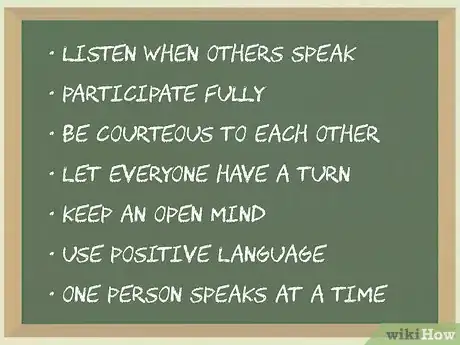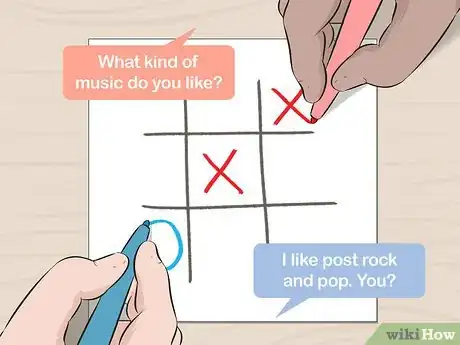This article was co-authored by wikiHow Staff. Our trained team of editors and researchers validate articles for accuracy and comprehensiveness. wikiHow's Content Management Team carefully monitors the work from our editorial staff to ensure that each article is backed by trusted research and meets our high quality standards.
There are 13 references cited in this article, which can be found at the bottom of the page.
This article has been viewed 22,073 times.
Learn more...
Conversational English can be difficult for anyone to learn, so teaching it can be a challenge! The main goals in a conversational English class are to encourage learners to build vocabulary and practice speaking as much as possible. You can also introduce fun activities that engage your students in learning English.
Steps
Establishing a Structure for Conversation Class
-
1Establish conversational rules and guidelines before getting started. Talk with your students during your first class to come up with a set of guidelines for your classes. You can suggest rules, but you can also ask your students to make suggestions. Everyone should agree to these guidelines, and you can keep them posted in the classroom.[1]
- Prepare a few ahead of time that you can write on the board, which will help the conversation along.
- For instance, some guidelines could be "Be courteous to each other; no name-calling" and "Let everyone have a turn."
-
2Emphasize meaning over correctness in class at first. When you first start out, let the students know that your main focus will be to get meaning across. Correctness is important, but if everyone can understand what the person is saying, that's more important. In practice, this may mean that you don't stop the conversation just because someone's syntax was off.[2]
- While students will be concerned about correctness, let them know that even native speakers don't say things correctly all the time in conversation.
Advertisement -
3Work on the day’s vocabulary at the beginning of each class. If you have novice or intermediate speakers, they may need help with the words to speak about certain topics. For instance, if you want to talk about the weather one day, start by introducing words that students can use to discuss it, such as "rainy," "cloudy," "sunny," and "windy."[3]
- Write these on the board for the students to see or hand out a sheet with the words on it.
-
4Match the discussion topics to your students’ levels. Make sure you know what level your students speak at. You don't want to introduce a complex topic to beginning speakers; they don't have the skills yet to talk about it. Instead, stick to topics that are interesting but simple enough for your students to grasp.[4]
- Ask your students about topics they are interested in. You could even give a survey to your students in your first class to both establish their speaking level and ask for topic ideas.
- For other simple topics, try conversing about food, talking about their families, or discussing what they did over the weekend.
-
5Avoid controversial topics when you can. Typically, you want to keep your class smooth and easy-going so that everyone feels welcome and included. For that reason, you may want to stay away from hot-button topics like politics, religion, and topics that may have a sexual nature.[5]
- However, if these topics do come up and you feel comfortable with it, allow things to take their natural course. Just ensure that the students stay respectful of each other and allow each person to have their say.
-
6Allow student-led discussion once your students are at the intermediate level. If your students are already decent speakers, they may be willing to step up and take the lead when it comes to topics. You could even ask 1 student each week to come up with a list of topics. Doing so ensures you get topics they're interested in![6]
- Encourage them to come up with a few vocabulary words and a list of questions to help keep the conversation going. Let them know that it's their job to get the conversation going not necessarily speak for a certain amount of time.
- You could also encourage them to lead the discussion, as that will help build confidence and conversation skills.
-
7Ask open-ended questions to encourage conversation. Asking "Yes" or "No" (closed-ended questions) requires students to understand what you're asking but not to answer fluently. Open-ended questions, or ones that require an answer beyond "Yes" or "No," ask students to formulate a response, which helps with conversation skills.[7]
- Plus, open-ended questions help move the conversation along.
- For instance, instead of saying, "Does this topic make you feel sad?" you could ask, "How does this topic make you feel?"
- Instead of "Do you like movies?" you could say, "Can you tell me about your favorite movie?"
-
8Let the conversation branch off into unexpected directions if your students are engaged.. While you'll likely establish a topic, you don't need to stick to it rigidly. The goal is to get the students talking to each other so if the conversation veers off in another direction, let it go, as long as the students are still enthusiastically engaged.[8]
- If the conversation gets heated or some of your students start to look uncomfortable, you may want to rein it back in to your original topic. You could say something like, "Let's switch gears a little bit and give this topic a break. Why don't we go back to what we were talking about earlier? June, I think you may have had something more to say about that."
Using Fun Activities
-
1Divide the group into pairs and give them a conversation topic and outline. Novice speakers often don't know where to begin. Give them a short script to jumpstart the conversation, then have them take it from there. Try picking a specific theme or topic to focus on. You can write the script on the board or simply hand it out to them on a sheet of paper.
- For example, you could choose the topic of "weather" and give your students this script to start:
- Student A: Hi, what do you think about the weather today?
- Student B: It's ____ (good, bad, okay). I ____(hate, love, like) ___ (cloudy, sunny, rainy, windy, etc.) weather. What's your favorite kind of weather?
- Student A: I like ____ (sunny, cloudy, rainy, etc.) weather.
- Ask the students at the end what they learned from their partners.
- For example, you could choose the topic of "weather" and give your students this script to start:
-
2Let the students discuss 2 related pictures to practice comparison speech. Put the pictures up where all the students can easily see them or pass out copies to everyone in the room. If you have a projector, use that to put the pictures up. Ask the students to discuss the differences between the pictures.[9]
- For example, you could ask students to compare an urban setting with a rural one or a desert with a lake. You could have students compare a messy bedroom versus a neat one.
- You could also do this in pairs.
-
3Play conversation-based games to encourage more talking. Try games like 20 questions, tic-tac-toe with conversation, Simon says, or even something like Mother, May I? These games will break up the monotony and encourage animated and engaged talking.
- For tic-tac-toe with conversation, pick a small talk topic (such as the weather, what's going on this afternoon, etc.) and divide the group in 4s. Have pairs within the group talk about the topic and the other set of pairs run a timer, then switch off. Set a time goal for each pair and if they reach that goal, they can mark an "X" or "O" in a tic-tac-toe square on the board.
- Set times based on the students' level. For instance, try 30 seconds for beginners, 1 minute for intermediate speakers, and 2 minutes for advanced students.
- Another way to use tic-tac-toe is to write out prompts for each square. If a student can answer the prompt, they can mark the square with an "X" or "O."[10]
-
4Set up a debate between 2 sides. Divide your students into 2 large groups and give each group one side of an argument. Give them time to gather materials and ideas to make their argument. Have them present their arguments and offer rebuttals to the other groups' statements.[11]
- You don't have to use controversial topics for this. You can try silly subjects like: "Peanut butter and jelly: Delicious or disgusting?" You can even bring in props for a debate like this (peanut butter and jelly sandwiches!).
-
5Create everyday situations by setting up your classroom like a shop, bank, or library. Students will need to be fluent in conversations they'll have in a lot of different situations, and re-creating those in your classroom can be fun and informative. For instance, one day you could set up your classroom like the bank or the airport, and have your students interact with you as if they were at those places.[12]
- You could even set aside a day where you re-create several of these at once, such as a bank, shop, and library, and have your students go to each one to complete certain tasks. Students can take turns playing the shopkeepers, librarians, and tellers, as well as the customers.
-
6Try blind telephone calls to help encourage emotional listening. Have students sit back to back in pairs and then go through a typical telephone call. You can have a script to read for novice students. The idea is to work on putting emotion in the words being said and to learn to listen for verbal cues when visual cues aren't available.[13]
Encouraging Learning outside of Class
-
1Ask students to consume media in English. Watching television or listening to the radio or podcasts can help students learn conversational English. Ask students to spend a little time each day consuming media to help grow their skills.[14]
- Tell students to look online for media in English if they live in a non-English speaking country. They can watch the news, look for children's movies (which will have simpler English), or even look for books for non-native speakers with simple words.
-
2Urge students to practice English when they're running errands. If you live in a country whose primary language is English, ask students to go out and talk to people like retail workers and bank tellers. Encourage them to use their English as much as possible with people they meet.[15]
- If you live in a country with another main language, look for any businesses in the area with native English speakers and encourage your students to try asking for things in English there.
-
3Request that students practice 10 minutes a day. Whether it's talking to the television or visiting with a friend, a little practice each day goes a long way. Just 10 minutes a day is helpful in reinforcing what they're learning in your class.[16]
- Practicing a little at a time rather than cramming it in all at once is the best way to learn a language!
-
4Have students translate words in their daily life to work on vocabulary. Ask students to put sticky notes up around the house for common items to reinforce vocabulary words. Similarly, tell them to translate notes like grocery lists and phone numbers into English to help those words stick in their minds.[17]
- They could also try things like practicing ordering at home to help them when they go out.
References
- ↑ https://busyteacher.org/14409-how-to-teach-conversational-english-best-practices.html
- ↑ https://busyteacher.org/14409-how-to-teach-conversational-english-best-practices.html
- ↑ https://busyteacher.org/14409-how-to-teach-conversational-english-best-practices.html
- ↑ https://www.britishcouncil.org/voices-magazine/few-discussion-activities-english-language-students
- ↑ https://www.britishcouncil.org/voices-magazine/few-discussion-activities-english-language-students
- ↑ https://www.britishcouncil.org/voices-magazine/few-discussion-activities-english-language-students
- ↑ https://www.edutopia.org/blog/teaching-your-students-conversation-allen-mendler
- ↑ https://www.britishcouncil.org/voices-magazine/few-discussion-activities-english-language-students
- ↑ https://www.britishcouncil.org/voices-magazine/few-discussion-activities-english-language-students
- ↑ https://www.britishcouncil.org/voices-magazine/few-discussion-activities-english-language-students
- ↑ https://www.listenandlearn.org/the-teachers-handbook/top-5-activities-to-use-in-a-conversation-class/
- ↑ https://www.listenandlearn.org/the-teachers-handbook/top-5-activities-to-use-in-a-conversation-class/
- ↑ https://www.listenandlearn.org/the-teachers-handbook/top-5-activities-to-use-in-a-conversation-class/
- ↑ https://www.businessinsider.com/ways-learn-foreign-language-as-adult-2019-1#4-read-familiar-books-in-a-new-language-4
- ↑ https://www.businessinsider.com/ways-learn-foreign-language-as-adult-2019-1#2-practice-in-your-community-2
- ↑ http://www.bbc.co.uk/languages/learn/
- ↑ http://www.bbc.co.uk/languages/learn/







































































